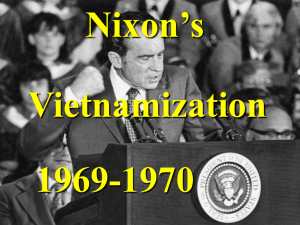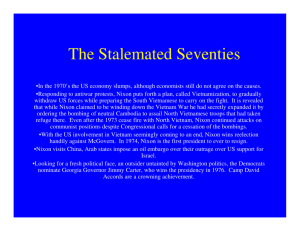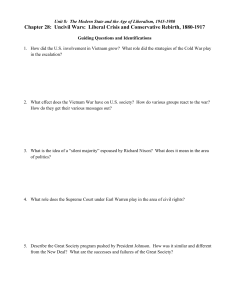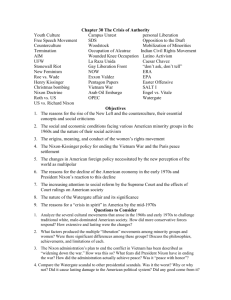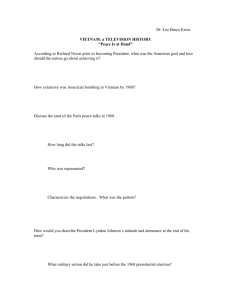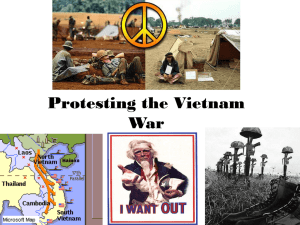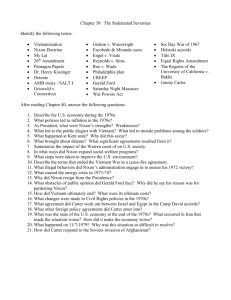Vietnam - Waverly-Shell Rock School District
advertisement
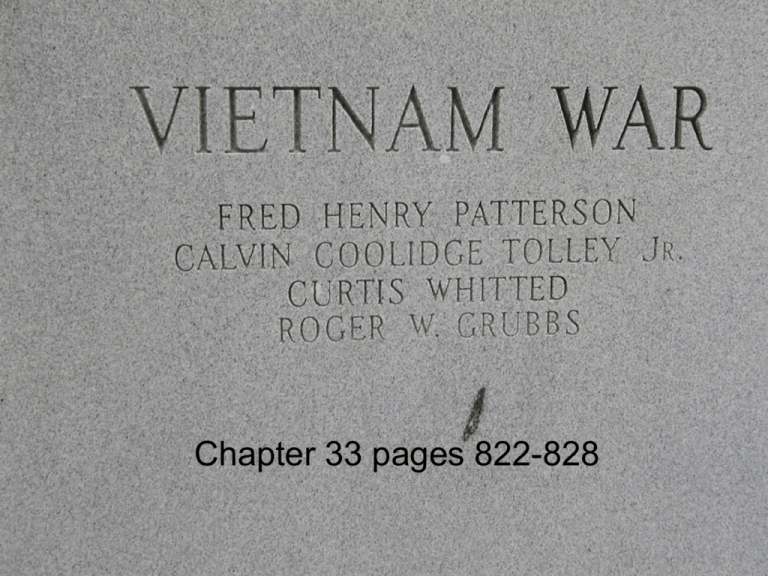
Chapter 33 pages 822-828 Vietnam #3 Reading Quiz 1) 2) 3) 4) 5) 6) What was the Cambodian Incursion? What happened at Kent State? What was the Sense of the Senate? What was Vietnamization? Why did Congress Repeal the Tonkin Gulf Resolution? What happened when the South Vietnamese army (ARVN) invaded Laos with U.S. help? 7) Why did Nixon increase bombing in North Vietnam and mine Haiphong Harbor? 8) How did the VietnamWar end? Situation in Vietnam prior to Nixon’s Election in 1968 5:12 min. Nixon’s Vietnam Policy 10:33 min Winding Down the War • Nixon’s Campaign Promise- 1968 • WINNING THE PEACE • During the campaign, Nixon claimed to have a "secret plan" to end the war. In the final days of the election, much was riding on the success or failure of the Paris Peace Talks with the North Vietnamese. He ruled out a “one sided withdrawal or the acceptance of terms that would amount to a disguised defeat. • ''Every American wants peace in Viet Nam. The question is what kind of peace. The war must be ended, but in a way that does not encourage aggression and thereby sow the seeds of future wars. • ''Beyond this, we need a new diplomacy -- one that looks past Viet Nam to the prevention of future wars, and one that enlists other nations more fully in their own defense. • "In Korea, and again in Viet Nam, America furnished most of the money and most of the arms -and most of the men. • "America is a big country. But there are only 200 million Americans, and there are more than 2 billion people who live in the free world. We need a new diplomacy that will get other nations with a stake in the defense of peace and freedom to bear their share of the burden. And we need a new diplomacy that will insure that, if the people of a friendly nation again are threatened, we help them fight the war but we don't fight the war for them." Nixon’s Secret War 2:44 min. Cambodian Incursion 1969-1970 • • • • • Nixon secretly widened the war to force the North Vietnamese to negotiate. Secret bombing of North Vietnamese and Cambodian bases in Cambodia While enlarging the war Nixon also began to withdraw troops. In 1970, the communists in Cambodia overthrew the leader Prince Sihanouk and took over (Khmer Rouge). U.S. and South Vietnamese leadership were concerned with Vietcong and North Vietnamese bases located in Cambodia across the South Vietnam border (Mekong River). President Nixon gave the approval for an April, 30, 1970 attack across the border into Cambodia by the Allies and U.S. Tanks- an incursion. This seemed to be in direct conflict with administration’s attempt to scale down the war (Vietnamization) Anti-War Protests 1969 • • • • In the United States the Cambodian incursion sparked renewed Anti-War reactions. Demonstrations got louder and stronger. Nixon appeals to the “Silent Majority” for support of the war. June 1969- “Sense of the Senate” barred military operations in any country without Congressional approval. June 24, 1970- Senate repealed the Tonkin Gulf Resolution. Kent State May 4, 1970 Protests against the Cambodian Incursion at Kent State University in Ohio caused the Governor to call out the National Guard. A frightened guard unit opened fire at the unarmed protestors killing 4. More that 80 colleges and universities suspended classes. Nixon and Vietnamization • The plan was to encourage the South Vietnamese to take more responsibility for fighting the war. • It was hoped that this policy would eventually enable the United States to withdraw gradually all their soldiers from Vietnam. • July 1969, the 540,000 US troops were to be reduced by 25,000. • To increase the size of the ARVN (Army of the Republic of Vietnam), a mobilization law was passed in South Vietnam that called up into the army all men between seventeen and forty-three years of age. Nixon and Vietnamization 4:30 min. "carrot and stick" strategy • Negotiate through strength • Nixon proposed "mutual withdrawal" of troops and no more bombing of North Vietnam- Jan. 25, 1969 • Nixon's advisers told him that they feared that the gradual removal of all US troops would eventually result in a National Liberation Front victory. It was therefore agreed that the only way that America could avoid a humiliating defeat was to negotiate a peace agreement in the talks that were taking place in Paris. • Madman Theory- In an effort to put pressure on North Vietnam in these talks. Bob Haldeman, one of the US chief negotiators, was told to give the impression that President Nixon was mentally unstable and that his hatred of communism was so fanatical that if the war continued for much longer he was liable to resort to nuclear weapons against North Vietnam. Phoenix Program • Another Nixon innovation- secret Vietnamese were trained by the CIA to infiltrate peasant communities and discover the names of NLF sympathizers. • When they had been identified, Death Squads were sent in to execute them. • Between 1968 and 1971, an estimated 40,974 members of of the NLF were killed in this way. • It was hoped that the Phoenix Program would result in the destruction of the NLF organization, but, as on previous occasions, the NLF was able to replace its losses by recruiting from the local population and by arranging for volunteers to be sent from North Vietnam. Ho Chi Minh Trail • The US could never stem the flow of supplies to the Ho Chi Minh Trail and this was crucial to keep the guerrilla war going. • Communist forces had been using what was then known as the Truong Son Route since at least 1959 to infiltrate men and materiel through Laos into South Vietnam. Not only was it a lifeline, it served as a basing area and a sanctuary in Laos for staging operations into South Vietnam. Vietnam 1970 • • • • • • • • North Vietnam invasion of Laos and Cambodia Feb. 21 - defeated Hmong army and captured Plain of Jarres - created Khmer Rouge Cambodia coup Mar. 18 - neutralist Sihanouk replaced by pro-U.S. Lon Nol Nixon saw film Patton Apr. 25 - made decision next day to invade Cambodia Cambodia invasion Apr. 30 - 32,000 U.S. troops attack the Fishhook and Parrot's Beak for 2 months - destroy NV supplies and set back NV plans for 2 years - a military success but political disaster Kent State demonstration May 4 against ROTC - 4 students killed Cooper-Church amendment to limit U.S. troops in Laos and Cambodia passed Senate 58-37 on June 30 Le Duc Tho and Kissinger met in Paris for 3rd round of talks in June Hatfield-McGovern amendment to require complete withdrawal from Vietnam failed in Sept. Vietnam 1971 • • • • • Winter Soldier investigation Jan. 31-Feb. 2 by John Kerry and the Vietnam Veterans against the War - 116 vets testified about atrocities committed by U.S. in Vietnam. Operation- Lam Son 719 - ARVN invade Laos Feb. 8 with U.S. air support - but failed to close the Ho Chi Minh trail and showed that Vietnamization had failed. Kissinger met with Le Duc Tho is secret talks in house on the Rue Darthe in Feb. rather than the formal talks at the Hotel Majestic, but stalled. Ping-pong team visit to China Apr. 10 Nixon ended of 21-year trade embargo in June. New York Times published Pentagon Papers June 13. • Vietnam 1972 • • • • • • • • Nixon arrived in China Feb. 21 - Shanghai Communique North Vietna invasion of Quang Tri Mar. 30 Nixon responded with Op. Linebacker Apr. 6 bombing north of DMZ - B-52 raids on Hanoi and Haiphong Apr. - 1,300 air strike sorties, May 1 - low point for Nixon's "Vietnamization" policy - collapse of SV seemed inevitable Le Duc Tho and Kissinger met in Paris May 2 - 4th round of talks fail - talks suspended May 4 Nixon decided May 8 to mine Haiphong harbor and blockade NV coast - 4 aircraft carriers added to 7th Fleet - massive bombing and "jugular diplomacy" successful Nixon arrived in Moscow May 22 - SALT I treaty signed May 29 - Brezhnev agreed to help pressure NV Le Duc Tho and Kissinger met in Paris July-Aug. 5th round of talks finally made progress - NV agreed to coalition government and Kissinger agreed to allow NV Kissinger TV press conference Oct. 26 - "peace is at hand” Nixon ultimatum to North Vietnam Dec. 14 to resume negotiations or "suffer the consequences" Vietnam 1973 • Kissinger and Le Duc Tho signed treaty Jan. 27 in Paris – POWs released in 60 days, return began of 591 U.S. POWs – ceasefire under International Commission of Control and Supervision (ICC), – coalition government in SV to arrange elections, U.S. aid to SV to continue • • • U.S. troops withdrawn by March, yet bombing continued. Congress cut off funds for war June 30, to become effective Aug. 15 War Powers Act passed Nov. 7 over Nixon's veto Fall of Vietnam and Indochina- 1975 • Vietnam – • Cambodia – • Fall of Saigon Apr. 29, 1975- Ambassador Graham Martin and 7100 U.S. and SV personnel evacuated Apr. 30, 1975 Khmer Rouge Laos – Pathet Lao and Pol Pot Cambodia and Khmer Rouge Pol Pot • The Khmer Rouge, led by Pol Pot, killed close to 1.7 million people in the mid- to late 1970s. • Money, private property, education and religion were abolished and Cambodia's towns and cities were emptied as the population was forced into massive, unworkable agricultural collectives. • In addition to death from work starvation and exhaustion, the regime killed anyone suspected with connections with either the defeated Khmer Republic government or the previous Sihanouk government, as well as intellectuals (Pol Pot defined anyone who wore glasses as automatically an intellectual), professionals, and also ethnic Vietnamese, Chinese, Chams, Laotians, and Thai. Laos and Pathet Lao • Left-oriented nationalist group in Laos that took control of the country in 1975. Founded in 1950, the Pathet Lao (Lao Country) movement joined with the Viet Minh • In 1975, the Communist Pathet Lao took control of the government, ending a sixcentury-old monarchy.
